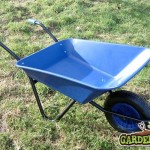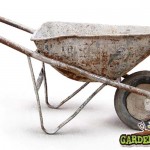Life for the garden wheelbarrow and be a rough ride and is all too often, cut short. Being constantly exposed to the tough external conditions of wind snow and rain the barrow must put up with a lot of hardship in it’s time. But today we want you to take the time and give your barrow some TLC.
- Retired WheelBarrow
- Blue Barrow
- Old WheelBarrow
Wheelbarrows are not a cheap acquisition and they seem to be getting more and more expensive every season. This is why it is even more important to take batter care of it.
There are many ways in which we can prolong the life of your wheelbarrow, and the first suggestion would be after care;
After using your barrow you should give it a good clean out. This task may sound easy now but when it’s the end of the day and a dirty wheelbarrow is all that stands between you and an evening of relaxation then it is often the barrow that losing out. Cleaning your barrow is essential to prevent it from rusting over, and if you have been using cement it is essential that you plan at least 10 minutes at the end of the day to clean it. When using cement you will need to scrub the barrow with a wire brush and rise 3 or 4 times with water. If done correctly then the cement will have no effect on the barrow.
The next important stage is the storage of your barrow. Again you should store it in a dray place and it should be stored dry. If you cannot dry your barrow before storing it then make sure that you tip the barrow up against a wall rather than leaving it sitting. This will allow it to dry further and prevent rust.
The wheels are the one area that take the most abuse. Driving over rough ground, thorns and other debris can take there toll on a barrow and it is generally not long before you find yourself needing to replace it. These days a new barrow wheel can cost about 15 to 20 euros, so this can add up very fast.
To prolong the life of your wheel you can have it pumped full of expanding foam instead of air- this makes the wheel almost indestructible and only costs around 10 euros more.
In terms of general maintenance on wheel barrows; remember to oil all moving parts every so often. Also check the nuts regularly as they really are prone to falling off. Probably the most common sign of an old barrow is that the bucket is falling off. If you tighten the nuts regularly then you can avoid this.
Before the winter give your barrow a good clean and then spray it over with WD40, this will coat and protect the steel prevent rust.
Always try to avoid any holes forming in the bucket of the barrow, as this can, in many cases, render the barrow useless. For example; using barrows to move water or cement can not be done if there is a hole in the barrow.
Lastly, if you really want to ‘pimp up’ and modify your barrow for maximum results then why not consider buying the barrow booster? This handy device fits over the top of your barrow allowing you to get even more holding capacity


